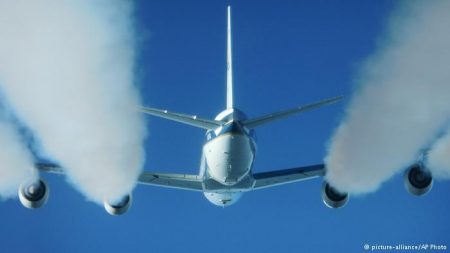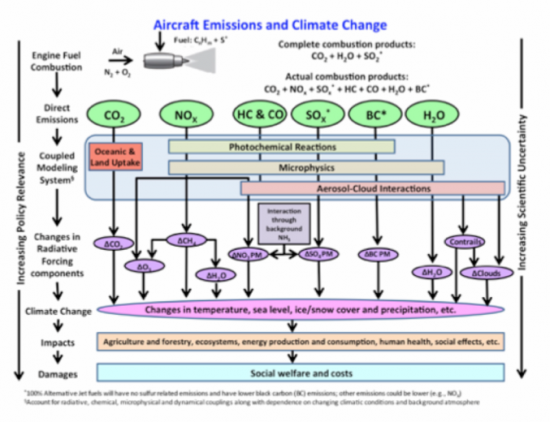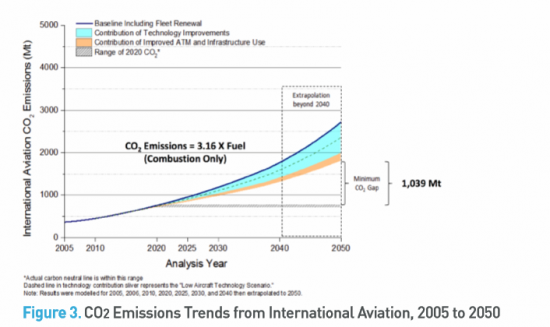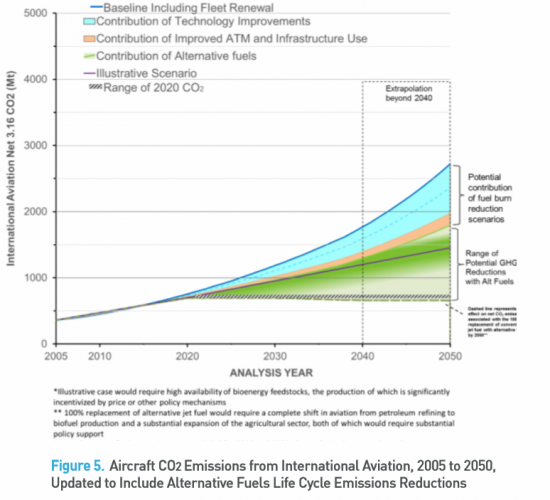October 7, 2016 – Two modes of transportation were not included in the final COP 21 agreement negotiated in Paris last year. One was marine shipping, and the other air was air traffic. Air traffic today contributes 1.3% of total anthropogenic carbon dioxide (CO2) emissions. Other aircraft emissions include nitrogen oxides (NOx), ozone (O3), methane (CH4), sulphur oxides (SOx) and black carbon aerosols. Aerosols combined with water vapour produce contrails in the upper atmosphere, contributing to cloud formation.
In 2010 global aviation consumed 142 million metric tons of fossil fuel which produced 448 million tons of CO2 emissions. By 2040, fuel consumption is expected to grow by as much as 2.8 to 3.9 times which means, if the fuels remain the same, the industry would be contributing well over 1 billion tons of CO2 to the atmosphere.
Those are the numbers today.
But yesterday marked the day when governments and the industry agreed collectively to reduce emissions from air traffic. At the 39th Session of the International Civil Aviation Organization (ICAO) in Montreal, the 190 countries signed on to a measure to address global emissions from air traffic.
Here are some of the details.
- A phased implementation referred to as a pilot based on voluntary participation beginning in 2021 through 2023.
- First phase to follow from 2024 to 2026.
- Second phase to begin in 2027 and end in 2035.
- 65 nations including the United States, China and European Union will participate in the pilot phase. By second phase all signatories are committed to participate.
- Mechanism to opt out.
- Measure for baseline in reductions based on emissions between 2019 and 2020.
- Measurable goals include a 2% annual fuel efficiency improvement.
- Carbon-neutral growth of aviation after 2020.
- New emission standards to reduce CO2 by 63% in 2050 and NOx by 60% by 2030.
- Shorter routes, less emission-intensive take offs and landings to reduce impact on local air quality, and adoption of technology to optimize aircraft performance.
- New replacement fuels to eliminate petroleum products starting with 2% alternative fuels in 2020 and 100% by 2050.
- New noise reduction standards including the potential for future supersonic forms of aircraft entering commercial operation.
- New aircraft introduced to air fleets to meet the objectives of carbon neutrality.
Through these measures the member nations of the ICAO hope to reduce the rate of growth in CO2 emissions expected as the industry expands. In the graph appearing below from the most recent ICAO Environmental Report it illustrates the expected gap reductions that the industry will gain from improvements to infrastructure and technological innovation. The remaining gap to achieve carbon neutral growth amounts to 1,039 Megatons.
So how does the industry intend to address the gap? The ICAO Carbon Offsetting and Reduction Scheme for International Aviation or CORSIA describes its strategies as MBM. It stands for market-based measures. The industry intends in the interim to use cap-and-trade (MBM) to buy credits to fill the emissions gap until innovation and alternative low-carbon fuels get developed. The goal would conceivably achieve carbon neutrality beginning as early as 2020.
Alternative low-carbon fuels replacing petroleum-based products would yield a net CO2 emission reduction of 63% as depicted in the graph below.
The agreement is expected to cost airlines about $5.3 billion U.S. at the onset, and by 2035 $23.5 billion annually. The projected cost to travelers is expected to amount to a fare increase from 50 cents on short routes to $7 on intercontinental and transcontinental flights.





















